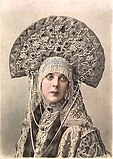Kokoshnik

The kokoshnik (Russian: кокошник) is a traditional Russian head-dress worn by women and girls to accompany the sarafan. It is patterned to match the style of the sarafan and can be pointed or round. It is tied at the back of the head with long thick ribbons in a large bow. The forehead is sometimes decorated with pearls. The woman or the girl usually wears her hair in a plait. It resembles the French hood worn in Tudor England, but without the veil.
The word kokoshnik first appears in the 16th century documents, and comes from the Old Slavic kokosh, which means a hen or a cockerell. However, the earliest head dress pieces of the similar type (rigid and completely covering the head) have been found in the 10th-12th cc. burials in Veliky Novgorod.[1]
Kokoshnik gave its name to the decorative corbel arch that was a distinctive element of traditional Russian architecture since 16th century (see kokoshnik in architecture).
During the revival of Russian national culture in the early 19th century, these diadem-shaped tiaras became part of the official court dress for royalty and ladies-in-waiting. It was worn by peasant girls and women on special occasions until the Russian Revolution.
After the Revolution kokoshnik was introduced into the Western fashion by Russian émigrés. Even before, it was a wedding head dress of Mary of Teck, the Queen consort of the United Kingdom.
Today kokoshniks are worn chiefly by girls and women in Russian folk ensembles. Kokoshnik is also a part of traditional costume of Snegurochka, the niece and assistant of Ded Moroz (the Russian Santa).
One of the costumes of Senator Padmé Amidala in the Star Wars saga, the Gold Travel Costume, was based on the Russian national costume with kokoshnik[2], known in the West from the photographs taken during 1903 Ball in the Winter Palace.
Examples
-
A little Grand Duchess Alexandra Pavlovna in kokoshnik and sarafan, 1790s.
-
Empress Alexandra Feodorovna (Charlotte of Prussia) in kokoshnik, 19th century.
-
A girl in kokoshnik by Mikhail Nesterov, 1885.
-
Boyaryshnya by Viktor Vasnetsov (the portrait of V. S. Mamontova), 1884.
-
Boyaryshnya with kokoshnik covered with veil. 19th-century painting.
-
A woman in the large, rich, two-horned kokoshnik. 1900s. Photograph.
-
Princess Orlova-Davydova in Masquerade Costume for the Ball of 1903. Photograph.







